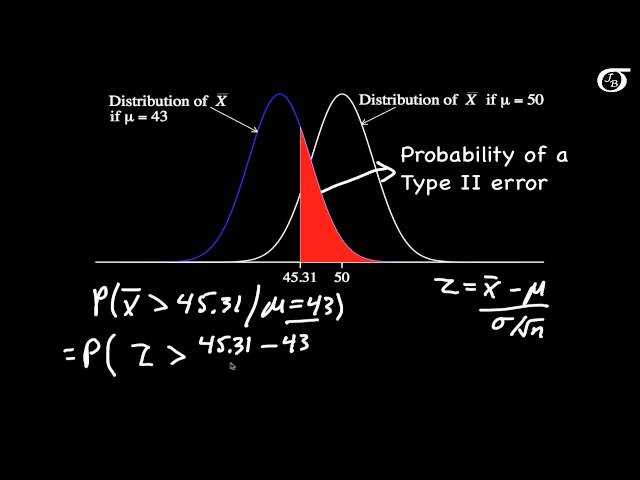Definition and Explanation of Type II Error
It is important to understand that Type II error does not imply that the null hypothesis is true. It simply means that there is not enough evidence to reject it based on the available data. This can lead to missed opportunities for discovering important relationships or effects in research.
One way to reduce the likelihood of Type II error is by increasing the sample size. A larger sample size provides more statistical power, making it easier to detect significant differences or relationships. Additionally, researchers can also adjust the level of significance or consider alternative statistical tests that may be more sensitive to detecting differences.
Overall, Type II error is an important concept in hypothesis testing and statistical analysis. It highlights the potential for failing to detect true effects or relationships, emphasizing the need for careful study design and analysis to minimize the risk of this error.
Factors Affecting Type II Error
| Factor | Explanation |
|---|---|
| Sample Size | A larger sample size increases the power of the test, reducing the probability of a type II error. With a larger sample, there is a higher chance of detecting a true effect. |
| Effect Size | The effect size refers to the magnitude of the difference or relationship being tested. A larger effect size increases the power of the test, making it easier to detect a true effect and reducing the probability of a type II error. |
| Significance Level | |
| Variability | The variability of the data affects the power of the test. If the data is highly variable, it may be more difficult to detect a true effect, increasing the probability of a type II error. |
| Statistical Test | The choice of statistical test can impact the probability of a type II error. Some tests may be more sensitive to detecting certain types of effects, while others may be less sensitive. |
| Assumptions | Violations of the assumptions underlying the statistical test can increase the probability of a type II error. It is important to ensure that the data meets the assumptions of the chosen test. |
By considering these factors and making informed decisions, researchers and analysts can minimize the probability of making a type II error and improve the accuracy of their conclusions.
Examples of Type II Error in Financial Analysis
In financial analysis, Type II error can occur in various situations where a false negative result is obtained. This means that the null hypothesis is not rejected, even though it is actually false. Here are some examples of Type II error in financial analysis:
1. Accepting a Worthless Investment

2. Failing to Detect Financial Fraud
Type II error can also occur when financial fraud goes undetected. For example, a company may conduct an audit to detect fraudulent activities. However, due to a Type II error, the audit fails to reject the null hypothesis that there is no fraud. As a result, the fraudulent activities remain undetected, leading to potential financial losses for the company.
3. Inaccurate Credit Risk Assessment
Another example of Type II error in financial analysis is when there is an inaccurate credit risk assessment. Financial institutions often assess the creditworthiness of individuals or businesses before granting loans. However, due to a Type II error, the institution fails to reject the null hypothesis that the borrower is not a credit risk. As a result, the institution may grant a loan to a high-risk borrower, leading to potential defaults and financial losses.
These examples highlight the importance of minimizing Type II error in financial analysis. It is crucial for companies and financial institutions to carefully evaluate the risks and potential consequences of making a Type II error, as it can have significant impacts on their financial performance and decision-making processes.
Comparison of Type II Error with Type I Error
When conducting statistical hypothesis tests, it is important to understand the difference between Type II error and Type I error. While Type I error occurs when a null hypothesis is rejected incorrectly, Type II error occurs when a null hypothesis is accepted incorrectly.
One way to differentiate between these two types of errors is by considering the consequences of each. Type I error is often considered more serious because it leads to false positives, which can have significant implications. For example, in a medical study, a Type I error would mean incorrectly concluding that a treatment is effective when it is not, potentially leading to harmful or ineffective treatments being implemented.
On the other hand, Type II error is often considered less serious because it leads to false negatives. This means that a true effect or relationship is not detected or concluded. While this may seem less harmful, it can still have important consequences. For example, in a criminal trial, a Type II error would mean failing to convict a guilty person, allowing them to go free and potentially causing harm to others.
In summary, Type II error and Type I error are two types of errors that can occur in statistical hypothesis testing. While Type I error involves incorrectly rejecting a null hypothesis, Type II error involves incorrectly accepting a null hypothesis. Both types of errors can have important consequences, but they differ in terms of the implications and the statistical power of a test. It is crucial to consider both types of errors when interpreting the results of hypothesis tests.

Emily Bibb simplifies finance through bestselling books and articles, bridging complex concepts for everyday understanding. Engaging audiences via social media, she shares insights for financial success. Active in seminars and philanthropy, Bibb aims to create a more financially informed society, driven by her passion for empowering others.
